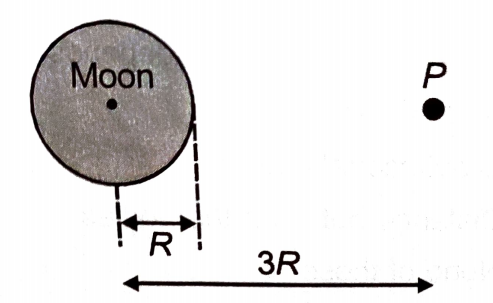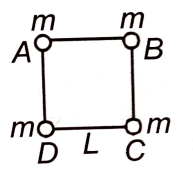An object is taken to height 2R above the surface of the earth, the increase in potential energy is: [R is the radius of the earth]
1.
2.
3.
4.
The change in potential energy when a body of mass m is raised to height nR from the earth's surface is: (R is the radius of the earth)
1.
2.
3.
4.
A stationary object is released from a point P at a distance of 3R from the centre of the moon which has radius R and mass M. Which of the following gives the speed of the object on hitting the moon?

1.
2.
3.
4.
Four particles A, B, C and D, each of mass m, are kept at the corners of a square of side L. Now the particle D is taken to infinity by an external agent keeping the other particles fixed with their respective positions. The work done by the gravitational force acting on the particle D during its movement is:

1.
2.
3.
4.
If an object is projected vertically upward with a speed equal to half the escape velocity on earth, then the maximum height attained by it is: [R is radius of earth]
1. R
2.
3. 2R
4.
If a satellite of mass \(400\) kg revolves around the earth in an orbit with a speed of \(200\) m/s, then its potential energy is:
1. \(-1.2\) MJ
2. \(-8.0\) MJ
3. \(-16\) MJ
4. \(-2.4\) MJ
An artificial satellite revolves around a planet for which gravitational force \((F)\) varies with the distance \(r\) from its centre as \(F \propto r^{2}.\) If \(v_0\) is its orbital speed, then:
| 1. | \(v_{0} \propto r^{-1/2}\) | 2. | \(v_{0} \propto r^{3/2}\) |
| 3. | \(v_{0} \propto r^{-3/2}\) | 4. | \(v_{0} \propto r\) |
If the gravitational potential on the surface of the earth is V0, then the potential at a point at a height equal to half of the radius of the earth is:
1.
2.
3.
4.
The total mechanical energy of an object of mass m projected from the surface of the earth with escape speed is:
1. Zero
2. Infinite
3.
4.
A body is thrown with a velocity equal to n times the escape velocity (ve). The velocity of the body at a large distance away will be:
1.
2.
3.
4. None of these






